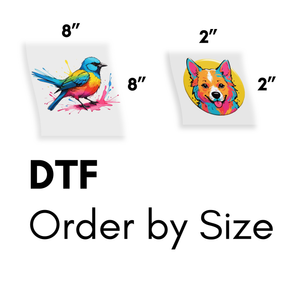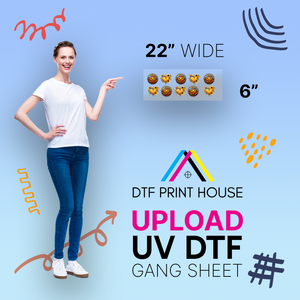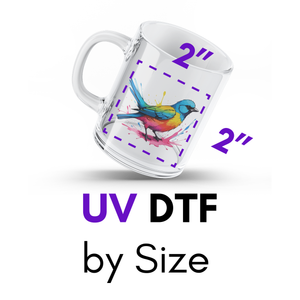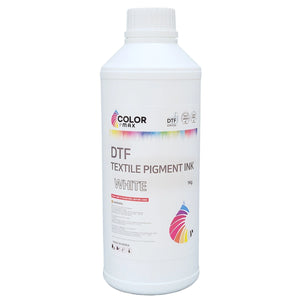DTF Printing Ink: The Essential Ingredient for High-Quality Transfers 🖨️✨
When it comes to DTF printing ink, the ink quality directly impacts the final design’s vibrancy, durability, and overall visual appeal. Direct-to-Film (DTF) printing allows creators to transfer vivid designs onto a variety of substrates like fabrics, wood, and metal. The ink used plays a pivotal role in the process. Without the right DTF ink, even the best equipment would struggle to produce excellent results.
In this article, we will dive into what DTF printing ink is, how it works, and why it's crucial for achieving professional-quality transfers. We’ll also explore the different types of DTF inks available, their benefits, and how they help you get the most out of your printing setup. 📘 For a deeper understanding of DTF printing technology, feel free to visit this Wikipedia page.
🌟 What is DTF Printing Ink? 🤔
DTF printing ink is a specialized ink designed for Direct-to-Film printing. This ink is formulated to work seamlessly with PET transfer films and the heat transfer process. Unlike traditional inkjet printers, DTF printers require ink that bonds well to the film, resists heat during the transfer process, and produces vibrant, long-lasting designs.
The ink contains pigments and chemicals that allow it to adhere to the transfer film. Once the ink is printed onto the film, adhesive powder is applied before heat pressing the design onto the desired substrate. This process results in high-quality, durable prints that can withstand multiple washes and usage.
🖨️ How Does DTF Printing Ink Work?
The printing process is relatively simple but highly effective. Here’s a step-by-step breakdown of how it works:
1. Ink Printing
The printer applies ink directly onto PET transfer film. The ink is deposited in layers, with each layer creating the design's vibrant colors.
2. Adhesive Powder Application
After printing, a special adhesive powder is sprinkled onto the wet ink. This powder helps it bond with the fabric or substrate during the heat transfer process. The powder is cured using heat or UV light to secure the ink.
3. Heat Transfer
Once the adhesive is cured, a heat press is used to transfer the design from the PET film to the fabric, hoodie, bag, or any other desired product. The high heat helps the ink bond to the fabric, ensuring a long-lasting print.
4. Final Results
The end result is a crisp, vibrant design with excellent durability, resistant to fading, cracking, and peeling even after multiple washes.
🏆 Why Is the Ink Important?
Using the right ink is crucial for achieving high-quality results in terms of print vibrancy, durability, and overall quality. Here are some reasons why it is an essential component:
1. Print Quality
The ink directly impacts the color vibrancy, sharpness, and overall quality of the print. High-quality ink produces crisp, clear designs with vivid colors.
2. Durability
This ink is formulated to withstand the heat transfer process. Once transferred to the fabric, the print remains intact, resisting fading, cracking, and peeling after multiple washes.
3. Color Accuracy
With this ink, you can achieve precise color reproduction, which is crucial for detailed and multi-colored designs. Whether you're working with gradients or fine lines, the right ink ensures accurate results.
4. Wide Material Compatibility
The ink works with a wide range of materials such as cotton, polyester, leather, and more. This makes it an ideal choice for printing on apparel, accessories, home décor, and promotional products.
🎨 Types of Ink
There are different types of ink available, each suited for specific applications. The most common types are:
1. Water-Based Ink 💧
Water-based ink is the most commonly used type. It is eco-friendly, easy to work with, and provides vibrant colors. This type is suitable for a wide range of materials, particularly fabrics.
2. Solvent-Based Ink 🛢️
Solvent-based ink is more durable and robust. It is ideal for harder materials such as leather, wood, and metal. However, it tends to have a stronger odor and is less eco-friendly compared to water-based ink.
3. UV Ink 🌞
UV ink is cured using ultraviolet light, making it an excellent option for printing on hard materials like wood, glass, and metal. UV ink offers excellent resistance to scratching, fading, and wear, ensuring long-lasting prints on both fabric and hard goods.
🧳 Common Applications of Ink
It is versatile and can be used for a variety of printing applications, including:
-
Custom Apparel: T-shirts, hoodies, and sweatshirts with unique designs.
-
Promotional Products: Custom mugs, tote bags, hats, and other items.
-
Personalized Gifts: Print designs on items like phone cases, keychains, and pillows.
-
Hard Goods: Use UV ink for printing on wood, glass, or metal surfaces.
💡 Best Practices for Using Ink
To ensure the best results, follow these tips:
1. Use the Right Ink for the Material
Ensure that you choose the correct type of ink depending on the material you're working with.
2. Maintain Your Printer
Regularly clean your printer, including the print heads, to ensure smooth ink flow and even application.
3. Proper Curing
Make sure the ink is properly cured before transferring it to the fabric or surface. Curing helps set the design and ensures durability.
4. Adjust Printer Settings
Optimize your printer's settings to match the material you are printing on. This ensures the ink is applied correctly for optimal results.
🔗 Internal Link Suggestion
Looking for the best supplies? Visit our Ink Collection for top-quality options that guarantee vibrant, durable prints. 🛒
✅ Final Thoughts
DTF printing ink is a critical component in achieving high-quality, durable prints in Direct-to-Film printing. Whether you're printing on apparel, promotional items, or hard goods, using the right ink ensures that your designs are vibrant, sharp, and long-lasting. With a variety of ink types available—water-based, solvent-based, and UV DTF inks—there’s a suitable option for every printing need. 🌈
If you're looking for the best DTF ink for your next project, check out our collection for premium options that produce professional results every time!

 Vendor:DTF Print House
Vendor:DTF Print House
 Vendor:DTF Print House
Vendor:DTF Print House Vendor:DTF Print House
Vendor:DTF Print House Vendor:DTF Print House
Vendor:DTF Print House






